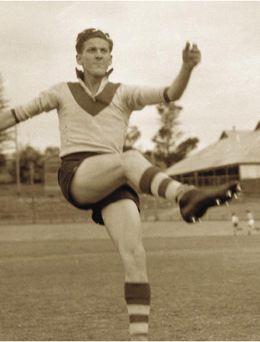|
HALL OF FAME INDUCTEE Bernard George Naylor |
|
|---|---|
| Year Inducted | 2004 |
| Date of Birth | 19th April 1923 |
PLAYER 1941-54
GAMES: 210 (South Fremantle 194; WA 16)
PREMIERSHIPS: 1947-48, 50, 52-54
HONOURS: Fairest and Best 1953; Leading WA Goalkicker 1946-48, 52-54; WA Player 1946-48, 52, 54
(Courtesy “WA’s Fabulous 40” by Alan East, 1984)
There is nothing more stimulating than a fast leading full forward, dragging down a mark and then steering a long punt kick through the goals. Just about the finest exponent of this style in post-war football would be former South Fremantle champion Bernie Naylor.
The figures speak for themselves. Over 1000 goals in nine seasons of league football, more than 100 goals in a season five times and an unbelievable 23 goals in one match. That haul came against Subiaco in 1953 and Naylor kicked 12 of those goals in one quarter. He kicked a record 156 goals in qualifying matches that season and by the end of the finals he had added 11 more to that tally.
The record stood until 1968 when, ironically, Subiaco full forward Austin Robertson kicked 157 goals in the season.
Naylor was a goalkicking genius and it must have been great for players up the field to know he was in their side. He perfected the torpedo punt and his team-mates could be confident that when he took a mark he would receive maximum value from his shot for goal.
The dynamic gold sneak had the uncanny ability to time his lead to perfection. After ridding himself of a close-checking opponent, by cleverly wrong-footing him, Naylor would use his pace to completely break away and accept a pass.
The Naylor torpedo was worth going a long way to see and he developed his own style. Instead of having the lace on top of the ball, he turned the ball about 45 degrees so that the lace was touching the palm of his right hand, a style that enabled him to spiral the ball with uncanny accuracy towards the target.
Naylor was a similar player to 1980’s champion Warren Ralph, both in his movements and size – although he was a more accurate kick, averaging 5.3 goals a game.
Naylor relied on his guile to get out into the open and accept a pass and he was particularly clever in his leading tactics.
Naylor’s career began in 1941, but he missed the next four seasons when the war intervened. He returned in 1946 and continued to dominate WA’s football until retiring in 1954.
Perhaps the one full-back who was able to best curb Naylor’s influence on the game was West Perth’s Ray Schofield. When these two players were at their respective clubs the two teams enjoyed their most successful eras and they played no small part in those successes.
And when West Perth played South Fremantle the tussle of the day would undoubtedly result when Naylor made his way down to full-forward to pit his skills against those of Schofield.
They had many memorable clashes and provided the big draw card for fans at the matches. However, over the years Naylor probably won out.



